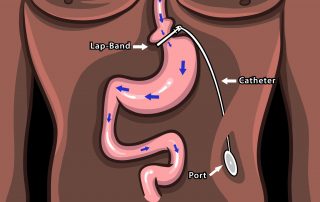Gastric Band

How the Gastric Band Works
(Although Dr. Quebbemann was an investigator for the FDA Trial for the Lap-Band, and has performed over 1000 Lap-Band procedures, he no longer performs the Lap-Band procedure.)
The Gastric Band is a hard, plastic device that is wrapped around the upper part of the stomach. It is attached by a thin tube, called a catheter, to a hollow reservoir in the shape of a disc. The disc-shaped reservoir has one hard side with a round metal plate and one soft side made of rubber. The entire system—reservoir (called a port), catheter, and band—is filled with saline (salt water).
When a bariatric surgeon places the band around your stomach, he connects it to the catheter and the port, placing the port below your skin but on top of your abdominal muscle. The port is positioned with the rubber side up and the metal plate down and stitched in position.
— Gastric Band diagram
In order to tighten or loosen your band, the surgeon will pass a small needle through your skin, through the rubber side of the port, and into the reservoir. The metal plate stops him from passing the needle too far. He will then add or withdraw saline, to tighten or loosen the band, as needed.
When a person with the Gastric Band eats, food passes down the esophagus into the small stomach pouch above the band, then passes through the band and into the stomach. Because the band restricts the flow of food through the upper stomach, a person with a Gastric Band will need to chew food very well to prevent it from getting stuck. Food will stay in the upper stomach for a while, giving the person a sense of “fullness,” before passing downward through the main portion of the stomach.
